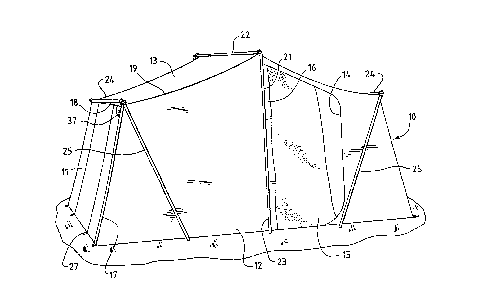Some of the information on this Web page has been provided by external sources. The Government of Canada is not responsible for the accuracy, reliability or currency of the information supplied by external sources. Users wishing to rely upon this information should consult directly with the source of the information. Content provided by external sources is not subject to official languages, privacy and accessibility requirements.
Any discrepancies in the text and image of the Claims and Abstract are due to differing posting times. Text of the Claims and Abstract are posted:
| (12) Patent: | (11) CA 2115090 |
|---|---|
| (54) English Title: | VENTILATOR FOR TENT |
| (54) French Title: | AERATEUR DE TENTE |
| Status: | Expired and beyond the Period of Reversal |
| (51) International Patent Classification (IPC): |
|
|---|---|
| (72) Inventors : |
|
| (73) Owners : |
|
| (71) Applicants : |
|
| (74) Agent: | BORDEN LADNER GERVAIS LLP |
| (74) Associate agent: | |
| (45) Issued: | 1998-09-01 |
| (22) Filed Date: | 1994-02-07 |
| (41) Open to Public Inspection: | 1995-06-18 |
| Examination requested: | 1995-04-18 |
| Availability of licence: | N/A |
| Dedicated to the Public: | N/A |
| (25) Language of filing: | English |
| Patent Cooperation Treaty (PCT): | No |
|---|
| (30) Application Priority Data: | ||||||
|---|---|---|---|---|---|---|
|
A tent is provided with a ventilator opening in one
corner thereof. The tent includes a pair of side panels which
are secured together along a side seam and a top panel which is
secured to the side panels along a top seam. One of the side
panels is provided with an opening adjacent the top and side
seams, and a screen covers the opening. A skirt is secured to
the top and side seams and includes a free edge which is spaced
from the screen. A stiffener is secured to the skirt adjacent
the free edge thereof for maintaining the free edge away from
the screen.
La présente invention a pour objet une tente pourvue d'une ouverture destinée à recevoir un ventilateur et pratiquée dans un des coins. La tente comporte une paire de panneaux latéraux qui sont joints l'un à l'autre par une couture latérale et un panneau supérieur qui est joint aux panneaux latéraux par une couture supérieure. L'un des panneaux latéraux comporte une ouverture située au voisinage des coutures latérale et supérieure; une moustiquaire recouvre l'ouverture. Une jupe fixée aux coutures supérieure et latérales comporte un bord libre qui tombe devant la moustiquaire. Un élément raidisseur est fixé à la jupe à proximité de son bord libre et sert à maintenir celle-ci à distance de la moustiquaire.
Note: Claims are shown in the official language in which they were submitted.
Note: Descriptions are shown in the official language in which they were submitted.

2024-08-01:As part of the Next Generation Patents (NGP) transition, the Canadian Patents Database (CPD) now contains a more detailed Event History, which replicates the Event Log of our new back-office solution.
Please note that "Inactive:" events refers to events no longer in use in our new back-office solution.
For a clearer understanding of the status of the application/patent presented on this page, the site Disclaimer , as well as the definitions for Patent , Event History , Maintenance Fee and Payment History should be consulted.
| Description | Date |
|---|---|
| Inactive: IPC from MCD | 2006-03-11 |
| Time Limit for Reversal Expired | 2000-02-07 |
| Letter Sent | 1999-02-08 |
| Grant by Issuance | 1998-09-01 |
| Pre-grant | 1998-04-16 |
| Inactive: Final fee received | 1998-04-16 |
| Inactive: Correspondence - Prosecution | 1997-11-21 |
| Notice of Allowance is Issued | 1997-11-12 |
| Letter Sent | 1997-11-12 |
| Notice of Allowance is Issued | 1997-11-12 |
| Inactive: Status info is complete as of Log entry date | 1997-11-07 |
| Inactive: Application prosecuted on TS as of Log entry date | 1997-11-07 |
| Inactive: IPC removed | 1997-09-15 |
| Inactive: IPC removed | 1997-09-15 |
| Inactive: IPC assigned | 1997-09-15 |
| Inactive: First IPC assigned | 1997-09-15 |
| Inactive: IPC assigned | 1997-09-15 |
| Inactive: Approved for allowance (AFA) | 1997-09-12 |
| Application Published (Open to Public Inspection) | 1995-06-18 |
| Request for Examination Requirements Determined Compliant | 1995-04-18 |
| All Requirements for Examination Determined Compliant | 1995-04-18 |
There is no abandonment history.
The last payment was received on 1998-01-21
Note : If the full payment has not been received on or before the date indicated, a further fee may be required which may be one of the following
Patent fees are adjusted on the 1st of January every year. The amounts above are the current amounts if received by December 31 of the current year.
Please refer to the CIPO
Patent Fees
web page to see all current fee amounts.
| Fee Type | Anniversary Year | Due Date | Paid Date |
|---|---|---|---|
| MF (application, 4th anniv.) - standard | 04 | 1998-02-09 | 1998-01-21 |
| Final fee - standard | 1998-04-16 |
Note: Records showing the ownership history in alphabetical order.
| Current Owners on Record |
|---|
| COLEMAN COMPANY, INC. (THE) |
| Past Owners on Record |
|---|
| DAVID J. BAMBER |
| MARTIN W. PARK |